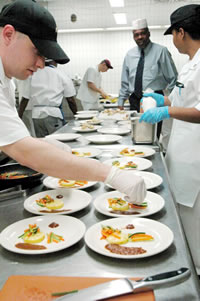The Fail-Proof Recipe for Creating the Perfect Team to Complete a Task or Project
Have you ever tasted a truly sumptuous dish and been compelled to ask how it was made? Typically you get a short rant that includes “a pinch of this and a dash of that.” In business (and other areas of life) we often ask the same question about putting together the perfect group of people to complete a task or project.  When it comes to the correct ingredients for a successful team, the recipe is consistent: allow form to follow function.
When it comes to the correct ingredients for a successful team, the recipe is consistent: allow form to follow function.
The cooking metaphor works for assembling a fantastic team of people: a pinch of this temperament, a dash of that temperament, then season to taste. As any cook will tell you, it takes practice, but there are some basics to help get things moving forward.
Gathering Your Ingredients
Because teams are made up of people, it may seem that the first ingredient to gather would be the individuals whom you believe would be excellent contributors to the team. However, this puts the cart a bit before the horse and does not take into account the goal of the team. Before recruiting people, you will want to do some goal assessment and planning.
At a minimum, you will want to know the following:
- What is the goal of the team?
- Why is a team being created? Is it the best way to move forward in the project?
- How will the team work together? Will tasks be assigned based on skill? Will each member be given the same task to complete (as in a customer service team)?
Other questions to consider include:
- When is the project deadline? Is this team working in deadline-specific situations?
- Where is the majority of the work taking place? Is the project place-specific?
These questions are key because they allow team builders to select team members with the temperament and skill set to meet the need of the specific goal or project. To select members prior to considering the facets of the project is likely setting the team up for high stress or even failure.
Combining the Ingredients
Now that you know the function of the team — goals, logistics, and purpose — you can begin to decide who will make effective contributions. Judicious use of your understanding of personality styles in planning will help you include just the right mix. An understanding of your own personality (or the personality of the team leader) will help you “season to taste.”
Consider the following general examples of how a team manager selected team members based on specific needs.
- Customer Service. Because this team was focused on delivering customer service, the team manager decided to build a team composed of 50% Blue, 10% Gold, 20% Green, and 20% Orange. The manager reasoned that a large part of delivering good customer service is the ability to listen and empathize with the customer. This is a natural strength of the Blue temperament, which is why this team was staffed heavily on the Blue side. In addition, this team needs a Gold to manage policy, Greens for problem solving tricky issues, and Oranges to balance stress in crisis or crunch situations.
- Sales. The goal of this team was to figure out how to increase sales despite a general economic recession. The manager staffed the team with 10% Blue, 20% Gold, 30% Green, and 40% Orange because this is essentially a problem solving and risk taking endeavor. Therefore the temperament combination needs to lean toward Orange and Green. However, the Greens and Oranges need checks and balances. Blues and Golds on the team will keep them on task, organized, and in touch with all prospective customers.
- Implementation. This goal of this team is to implement a plan once it has been established. The manager selected the following personnel: 20% Blue, 30% Gold, 20% Green, and 30% Orange. Once a decision has been made, an implementation team should be pretty balanced. This may differ depending upon the make up of the company or the department. It may also differ depending upon the policy itself. However, as a general rule, balance in implementation is a good thing. In this team, Blues and Golds use their organization and peacekeeping strengths. Greens streamline plans and strategies while keeping track of possible pitfalls. The positive Orange outlook and energy keeps things moving forward. Oranges are also strong presenters and cheerleaders for the plan.
Cooking up Success: Bon Appétit!
Once the team is in place, it’s time to work together toward the goal. No matter what the temperament makeup, there are likely to be both disappointments and successes. The suggestions and examples above are simply guidelines. You will need to alter your selections based on many factors. However, planning outcomes and choosing teams based on temperament strengths will certainly set your team up for movement toward the goal, which is, of course, success!
